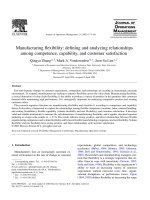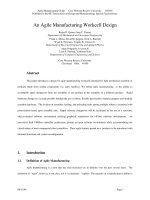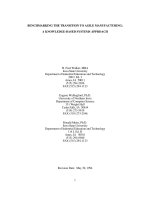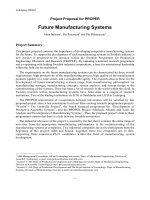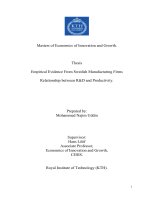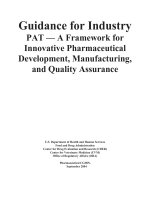Textile Yarn Manufacturing
Bạn đang xem bản rút gọn của tài liệu. Xem và tải ngay bản đầy đủ của tài liệu tại đây (486.8 KB, 18 trang )
TEXTILE
TEXTILE
Yarn Manufacturing
Yarn Manufacturing
W h at is Textile?
W h at is Textile?
Textile refers to any material made of
Textile refers to any material made of
interlacing fibers; hence textile raw
interlacing fibers; hence textile raw
materials are those fibers capable of
materials are those fibers capable of
being converted into yarns and fabrics
being converted into yarns and fabrics
FIBER YARN FABRIC
FIBERS
FIBERS
Cellulosic fiber
Cellulosic fiber
: Cotton, Bast fibers, Leaf
: Cotton, Bast fibers, Leaf
fibers, Coir, Kapok
fibers, Coir, Kapok
Protein fiber
Protein fiber
: Silk, Wool, Mohair,
: Silk, Wool, Mohair,
Cashmere, Camel hair
Cashmere, Camel hair
Synthetic fiber
Synthetic fiber
: Nylon, Nomex, Kevlar,
: Nylon, Nomex, Kevlar,
Polyester, Acrylic
Polyester, Acrylic
Mineral and Organic fiber
Mineral and Organic fiber
: Glass, Metallic
: Glass, Metallic
fiber and Carbon fiber
fiber and Carbon fiber
FIBERS
FIBERS
Length
Length
: must be several hundred times the width, to
: must be several hundred times the width, to
gives the necessary flexibility which enables them to
gives the necessary flexibility which enables them to
be spun into yarns.
be spun into yarns.
Tenacity or strength
Tenacity or strength
: to withstand the stresses
: to withstand the stresses
during spinning and weaving.
during spinning and weaving.
Elongation
Elongation
: specified as percentage of starting point
: specified as percentage of starting point
and it is importance since textile product without
and it is importance since textile product without
elasticity would hardly be usable.
elasticity would hardly be usable.
Uniformity
Uniformity
: fibers should have the same length,
: fibers should have the same length,
width and flexibility to produce even yarns
width and flexibility to produce even yarns
YARN
YARN
Yarn, by
Yarn, by
ASTM Standard D123, Vol 07.01
ASTM Standard D123, Vol 07.01
, is a
, is a
generic term for a continuous strand of textile
generic term for a continuous strand of textile
fibers, filaments or material in a form suitable
fibers, filaments or material in a form suitable
for knitting, weaving or otherwise intertwining to
for knitting, weaving or otherwise intertwining to
form textile fabric.
form textile fabric.
Yarns can be produces in different sizes and
Yarns can be produces in different sizes and
texture, and also vary in other characteristics.
texture, and also vary in other characteristics.
Performance and end use of the fabrics are
Performance and end use of the fabrics are
affected by these yarn characteristics.
affected by these yarn characteristics.
TYPES OF YARN
TYPES OF YARN
Staple or filament
Staple or filament
Single or plied or cord
Single or plied or cord
Simple or complex
Simple or complex
DIRECTION OF YARN
DIRECTION OF YARN
Yarns are twisted to hold the fiber
Yarns are twisted to hold the fiber
together.
together.
S Direction Z Direction
YARN SIZE / NUMBER
YARN SIZE / NUMBER
1) Direct System
1) Direct System
Weight in grams of 9000 meters of yarn
Denier
Tex
Decitex
Weight in grams of 1000 meters of yarn
Weight in grams of 10000 meters of yarn
2) Indirect System
Yarn count (s)
Length in hank of 1 pound of yarn (weighs)
1 hank = 840 yards
YARN SIZE / NUMBER
YARN SIZE / NUMBER
EXAMPLES:
EXAMPLES:
1.
1.
9,000 meters of yarn weighs 40 grams,
9,000 meters of yarn weighs 40 grams,
it is 40 denier yarns. The higher the
it is 40 denier yarns. The higher the
number of denier, tex or decitex, the
number of denier, tex or decitex, the
coarser the yarn.
coarser the yarn.
2.
2.
10 hanks of cotton yarn that weight one
10 hanks of cotton yarn that weight one
pound, this is 10s (count) yarn. The
pound, this is 10s (count) yarn. The
higher the number of yarn count, the
higher the number of yarn count, the
finer the yarn.
finer the yarn.
YARN
YARN
MANUFACTURING
MANUFACTURING
PROCESS
PROCESS
BLOWROOM
CARDING
DRAWING
ROVING
RING FRAME
COMBING
BLOWROOM
BLOWROOM
first step of cotton yarn
first step of cotton yarn
production
production
for opening, cleaning and
for opening, cleaning and
dust removal, blending,
dust removal, blending,
and prepared for carding
and prepared for carding
process.
process.
CARDING
DRAWING
ROVING
RING FRAME
COMBING
BLOWROOM
CARD ING
CARD ING
FUNCTIONS:
FUNCTIONS:
Opening to the individual fibers.
Opening to the individual fibers.
Elimination of impurities
Elimination of impurities
Elimination of dusk
Elimination of dusk
Disentangling of neps
Disentangling of neps
Elimination of short fibers
Elimination of short fibers
Fiber blending
Fiber blending
Fiber orientation
Fiber orientation
Sliver formation
Sliver formation
CARDING
DRAWING
ROVING
RING FRAME
COMBING
BLOWROOM
Main Parts:
Main Parts:
1.
1.
Taker in
Taker in
-
-
to open flocks out
to open flocks out
of the feed batt, to lead them
of the feed batt, to lead them
to the dirt-eliminating parts
to the dirt-eliminating parts
under the roller and to deliver
under the roller and to deliver
them to the main cylinder
them to the main cylinder
2.
2.
Main cylinder
Main cylinder
-
-
separate the
separate the
fibers, pull them into
fibers, pull them into
somewhat parallel form.
somewhat parallel form.
3.
3.
Doffer
Doffer
-
-
to take the individual
to take the individual
fibers from the main cylinder
fibers from the main cylinder
and condense them to web
and condense them to web
form
form
CARDING
CARDING
CARDING
DRAWING
ROVING
RING FRAME
COMBING
BLOWROOM
DRAWING
DRAWING
Functions:
Functions:
To improve evenness of the sliver
To improve evenness of the sliver
To arrange fiber in parallel
To arrange fiber in parallel
Blending
Blending
Dust removal
Dust removal
Drawframe has a series of rollers (drafting arrangement) rotating at
Drawframe has a series of rollers (drafting arrangement) rotating at
different rates of speed.
different rates of speed.
CARDING
DRAWING
ROVING
RING FRAME
COMBING
BLOWROOM
COMBING
COMBING
to upgrade the raw material
to upgrade the raw material
by removing the short fibers.
by removing the short fibers.
Combed yarn is stronger,
Combed yarn is stronger,
more uniform, has greater
more uniform, has greater
shine, smoother and purer
shine, smoother and purer
Functions:
Functions:
Eliminate short fibers
Eliminate short fibers
Eliminate remaining impurities
Eliminate remaining impurities
Eliminate neps
Eliminate neps
CARDING
DRAWING
ROVING
RING FRAME
COMBING
BLOWROOM
ROVING
ROVING
Functions:
Functions:
The attenuation of the sliver.
The attenuation of the sliver.
Impart protective twist in order to
Impart protective twist in order to
increase the strength of slivers.
increase the strength of slivers.
Winding of the roving into a
Winding of the roving into a
package that can be transported,
package that can be transported,
stored and used on the ring
stored and used on the ring
spinning.
spinning.
CARDING
DRAWING
ROVING
RING FRAME
COMBING
BLOWROOM
SPINNING
SPINNING
final step on producing yarn
final step on producing yarn
Functions:
Functions:
Attenuate the roving until required
Attenuate the roving until required
fineness is achieved
fineness is achieved
To impact strength to the fiber strand
To impact strength to the fiber strand
by twisting it
by twisting it
To wind up the resulting yarn in a
To wind up the resulting yarn in a
suitable for storage, transportation
suitable for storage, transportation
and further processing
and further processing
CARDING
DRAWING
ROVING
RING FRAME
COMBING
BLOWROOM
SPINNING
SPINNING
Front zone
draft
Middle zone
draft
Back zone
draft
